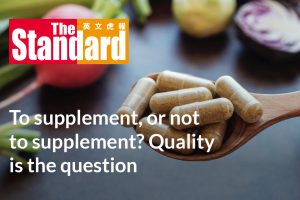Over six percent of children and adolescents are affected by ADHD in Hong Kong, according to the largest ADHD study ever published. Year-on-year, the numbers are rising. Since 2001, the use of ADHD medications in young Hong Kongers increased 36 times. In 2001, 1 in 2,500 children were on ADHD medication compared to 1 in every 69 children in 2015.
Inattentive. Hyperactive. Impulsive. Talkative. Easily distracted. Forgetful. These are the signs that might prompt a teacher to suggest a child seek a diagnosis. In light of these symptoms, a doctor may prescribe Ritalin or a similar stimulant drug to suppress ADHD-like traits. Why? Because scientists have observed a link between symptoms of ADHD and lower levels of dopamine – the neurotransmitter associated with motivation, pleasure, attention, and movement. Ritalin artificially increases dopamine levels.
However, scientists have yet to unearth the exact cause of ADHD. Genetics is known to be a significant factor. Environmental factors are important contributing triggers too. Stimulant drugs, whilst effective for up to two-thirds of people, do not address these factors. They come with a long list of side effects from mood swings and headaches to worrying risk of suicidal ideation, and the long-term impact is still unknown. It’s no wonder that Ritalin has a black box warning: the most serious warning from the US Food and Drug Administration (FDA).
Boosting brain potential naturally
Medication does not have to be your first port of call. Instead, it can be your last resort.
Here are five approaches that can help reduce the impact of nutritional and environmental factors of ADHD.
1. Bring back breakfast
A staggering 30% of students in Hong Kong skip breakfast. Research shows that students who eat breakfast every day perform better academically than their counterparts who skipped breakfast. Improved memory, concentration levels, behaviour, mood and lowered stress levels have also been linked to a healthy breakfast.
Our brains need glucose to function. Although fat reserves can be called on, breakfast typically restores glucose levels before children start their day at school. When kids skip on breakfast, they can experience functional hypoglycaemia, also known as low blood sugar. This increases adrenalin, and reduces dopamine and serotonin. The effects: irritability, argumentativeness, lack of concentration, anxiety, mood swings and headaches.
Bring kids back to the breakfast table!
2. Say no to sugar
Not just any breakfast will do. Breakfast cereals – even seemingly harmless cornflakes and rice crispies – have an extremely high glycemic index, which means your child is basically eating spoonfuls of pure sugar. Quickly absorbed by the body, cereals cause a rapid peak in blood sugar levels, which the body responds to by releasing excess insulin. Blood sugar levels drop dramatically about an hour later and, by the end of the first lesson, the offending cereal results in low blood sugar. The hungry brain searches for more sugar encouraging children to reach for a sweet snack at recess. The rollercoaster of blood sugar highs and lows continues throughout the day affecting mood, behaviour and concentration.
Children who supposedly have ADHD are actually sensitive to low blood sugar levels. What they have is ‘functional hypoglycaemia’, which triggers irritability, poor concentration, anxiety and low energy when the brain isn’t nourished appropriately.
Start the day the right way: oats, eggs (a vital source of choline for brain growth), unrefined breads, fish, vegetables, fruits, nuts and seeds are all brain-boosting foods that release energy slowly and regulate blood sugar levels. And for the rest of the day, steer clear of refined sugars. White bread, crisps, white rice, brown rice cakes, rice bubbles and white potatoes are all high-glycemic. In fact, they are often more sugary than sugar!
Removing sugar, sodas, or white-flour junk food from the diet is often the only thing needed in this situation, along with supplements that help balance blood sugar.
3. Say no to additives
Multiple studies indicate that food additives are a trigger for children that are genetically predisposed to hyperactivity. In fact, over 70% of children with ADHD are proven to benefit from an additive-free diet. Even children who do not have ADHD become restless when they consume many types of food colourings and preservatives.
Most children with ADHD suffer from food sensitivities to colours, flavours and preservatives; if they also have allergic sneezing or asthma, they are often sensitive to salicylates or natural aspirins found in foods too. All children with ADHD should avoid preservatives and artificial colours.
Food intolerances, such as to gluten and dairy, can cause low-grade inflammation in the body and the brain, so it’s important to identify these hidden culprits as well.
Test for the truth: The IgG test for food intolerances, is a simple finger-prick blood test that can identify antibody reactions to a comprehensive range of foods.
4. Be good to your gut
The gut and brain are inextricably linked. There is no denying an upset tummy upsets the mood and mind. Bloating, stomach pain, irregular bowel movements and more – these are common signs the gut biology is unbalanced. Once the good probiotic gut flora is reduced, gut immunity is impaired, and the child becomes prone to Candida, Clostridium or other bacterial overgrowth.
These infections produce high levels of toxins, which can impair the brain. Clostridium toxins, which interfere with dopamine levels, learning and psychology, tends to create a hyperactive effect. Candida toxins typically produce a ‘dreamy’ effect – leading to poor focus and concentration.
Other bacterial gut infections affect the brain and lower serotonin. Children can become worried and fussy, rigid, disliking change and prone to developing little rituals and compulsions – a mild obsessive-compulsive behaviour pattern found in some neurodivergent children with gut problems.
We offer a range of tests to identify the presence of yeast or bacterial overgrowth in the gut, brain inflammation, and pollution load. Digestive testing can help identify if gut issues are contributing to your child’s symptoms of ADHD. The test requires only one urine sample.
5. Take out toxins
Did you know newborn babies – before a single breath – have measurable amounts of up to 200 known or suspected developmental neurotoxins? This is especially relevant in Hong Kong given our poor environmental quality and exposure to heavy metals.
The levels of organophosphate pesticides sprayed routinely onto commercial crops is a commonly established environmental cause of ADHD. The levels found in the blood or urine of children correlate to the severity of ADHD symptoms – increased anger and oppositional tendencies, more impaired reflexes such as poor hand-eye coordination and psychomotor development, and less physical and mental endurance.
There’s a stark and obvious contrast in energy levels of children impacted by pesticides and children that are not. But pesticide-affected children are not ‘lazy’; they’re simply too polluted to function properly at the cellular level.
Take out toxins: Through simple, yet comprehensive testing, we can identify the toxins affecting your child’s brain.

無藥物治療ADHD
根據研究顯示,香港有超過6%的兒童和青少年受到ADHD的影響。與去年同期相比,這個數字更逐年上升。自2001年以來,香港年輕人使用ADHD藥物的比例增加了36倍。2001年時,每2500名兒童中有1人接受ADHD藥物治療,而2015年時則為每69名兒童中有1人使用。
注意力不集中、過動、衝動、多話、容易分心、健忘等都有可能是專注力不足過動症的徵兆。根據這些症狀,醫生可能會處方類似利他能的興奮劑藥物來抑制多巴胺水平。
然而,科學家尚未找出ADHD的確切原因。巳知遺傳是重要因素,環境因素也是關鍵的觸發因素。刺激劑藥物雖然對三分之二的人有效,但無法解決根源問題。藥物亦會帶來一連串副作用,例如頭痛和情緒波動等心理影響,其長期影響仍未知。
自然提升大腦潛力
以下是五種以營養角度和環境因素出發,幫助孩子減輕ADHD症狀:
1. 重視早餐的重要性
香港有30%的學生不吃早餐。研究顯示,每天吃早餐的學生在學業上表現比那些不吃早餐的學生更好。改善記憶力、專注力、行為、情緒和降低壓力水平也與健康的早餐有關。
我們的大腦需要葡萄糖才能發揮作用。儘管可以利用脂肪儲備,但早餐可幫助孩子於上學前恢復血糖水平。當孩子們不吃早餐時,他們可能會經歷功能性低血糖,從而增加腎上腺素,其減少多巴胺和血清素。其影響包括煩躁、注意力不集中、焦慮、情緒不穩定和頭痛等ADHD相關症狀。
2. 對糖說不
早餐。 早餐麥片,即使是看似無害的玉米片和脆米片——也具有極高的血糖指數。 穀物很快就被身體吸收,導致血糖水平迅速上升,身體會透過釋放過量的胰島素來做出反應。 大約一個小時後,血糖值急劇下降,第一堂課結束時,不良穀物會導致低血糖。 飢餓的大腦會尋找更多的糖分,鼓勵孩子在休息時間吃一些甜食。 血糖的高低起伏持續一整天,影響情緒、行為和注意力。
據稱患有多動症的兒童實際上對低血糖水平很敏感。 他們患有的是“功能性低血糖”,當大腦得不到適當的營養時,會引發煩躁、注意力不集中、焦慮和精力不足。
以正確的方式開始新的一天:燕麥、雞蛋(大腦生長的膽鹼的重要來源)、未精製的麵包、魚、蔬菜、水果、堅果和種子都是健腦食品,可以緩慢釋放能量並調節血糖水平。 在這一天剩下的時間裡,避免食用精製糖。 白麵包、洋芋片、白飯、糙米糕、米泡和白馬鈴薯都是高血糖的。 事實上,它們的含糖量往往比糖還高!
在這種情況下,通常唯一需要做的就是從飲食中去除糖、蘇打水或白麵粉垃圾食品,同時補充有助於平衡血糖的補充劑。
3. 對添加劑說不
多項研究表明,食品添加劑是遺傳上易患多動症的兒童的誘因。 事實上,超過 70% 的過動症兒童已被證明可以從無添加劑飲食中受益。 即使沒有過動症的孩子在食用多種食用色素和防腐劑時也會變得焦躁不安。
大多數患有多動症的兒童對食物的顏色、口味和防腐劑過敏; 如果他們還患有過敏性噴嚏或氣喘,他們通常也對食物中的水楊酸鹽或天然阿斯匹靈敏感。 所有患有多動症的兒童都應避免使用防腐劑和人工色素。
食物不耐受,例如對麩質和乳製品的不耐受,可能會導致身體和大腦出現輕度炎症,因此識別這些隱藏的罪魁禍首也很重要。
如果想得到確切的答案,可以進行食物不耐受的 IgG 測試(一種簡單的指尖採血測試),可以識別對各種食物的抗體反應。
4. 善待並關注腸道健康
腸道和大腦有著千絲萬縷的關係。 不可否認,胃部不適會擾亂情緒和精神。 腹脹、胃痛、排便不規律等等——這些都是腸道生物學不平衡的常見跡象。 一旦腸道有益菌叢減少,腸道免疫力就會受損,孩子就容易出現細菌感染。
這些感染會產生高濃度的毒素,會損害腦部、影響多巴胺水平、學習和心理,往往會產生過度活躍的效果或導致注意力不集中。其他細菌性腸道感染會影響大腦並降低血清素。 孩子可能會變得憂慮、消極和情緒失調。
我們提供一系列測試來識別腸道中是否存在酵母或細菌過度生長、大腦發炎和污染負荷等健康問題。 消化系統檢查可以幫助確定腸道問題是否導致孩子出現過動症症狀。
5. 清除體內毒素
鑑於香港的環境品質較差且容易接觸到重金屬,加上噴灑在農作物上的有機磷殺蟲劑是導致過動症的一個普遍的環境因素。 兒童血液或尿液中發現有機磷殺蟲劑的水平與過動症狀的嚴重程度相關。
受農藥影響的兒童和未受農藥影響的兒童的能量水平有鮮明對比。 如果想排除毒素,可以透過簡單而全面的測試去識別影響孩子大腦的毒素。



